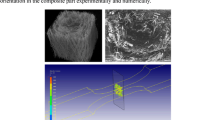Abstract
Chopped strands of glass fiber reinforced polymerized dicyclopentadiene (p-DCPD) was manufactured and mechanical properties were assessed. For the purpose, a lab-scale long fiber spray-up molding apparatus had been designed and built. Polydicyclopentadiene (p-DCPD) is a crosslinking polymer with a very rigid network structure resulting excellent mechanical and corrosion resistant properties. In this research, the length of the glass fiber roving was cut such that it would be 100 times its critical length. Uniformity of the fiber volume distribution was examined by varying the spray height, glass fiber weight percentage and the fiber length. Mechanical properties were measured for each processing conditions. It was found that tensile strengths of the specimen fabricated with 50 mm glass fiber were higher over the shorter (25 mm) fiber only if sufficient spray height was achieved. It is definitely desirable to use long strands of chopped glass fibers for composite fabrication processes however; a careful manufacturing precaution is required since the effect of the adhesion force between long fibers from the fiber entanglement cannot be ignored.
Similar content being viewed by others
References
P. K. Mallick and S. Newman, “Composite Materials Technology Processes and Properties”, p.13, Munich-Vienna, Newyork, 1990.
M. R. Kessler and S. T. White, J. Polym. Sci., 40, 2373 (2002).
H. M. Yoo, D. J. Kwon, J. M. Park, S. H. Yum, and W. I. Lee, e-Polymers, 17, 159 (2017).
H. M. Yoo, J. H. Jeon, M. X. Li, W. I. Lee, and S. W. Choi, Compos. Part B-Eng., 161, 439 (2019).
T. A. Davidson and K. B. Wagener, J. Mol. Catal A: Chem., 133, 67 (1998).
S. Billiet, X. K. D. Hillewaere, R. F. A. Teixeira, and F. E. Du Prez, Marcromol. Rapid. Commun., 34, 290 (2013).
S. Bluestone, S. D. Heister, S. F. Son, and B. L. Austin Jr, “Development of Composite Solid Propellants Based on Dicyclopentadiene Binder”, 46th AIAA/ASME/SAE/ ASEE Joint Propulsion Conference & Exhibit, AIAA 2010-6589, Nashville, TN, 2010.
Z. Yao, L. Zhou, B. Dai, and K. Cao, J. Appl. Polym. Sci, 125, 2489 (2012).
S. K. Mazumdar and S. Mazumdar, “Composites Manufacturing: Materials, Product, and Process Engineering”, 1st ed., pp.135–138, Chapman and Hall/CRC, 2001.
P. Feraboli, E. Peitso, F. Deleo, T. Cleveland, and P. B. Stickler, J. Reinf. Plast. Compos., 28, 1191 (2009).
M. Miwa, T. Ohsawa, and K. Tahara, Appl. Polym. Sci, 25, 795 (1980).
C. Jiang, K. Fan, F. Wu, and D. Chen, Mater. Des., 58, 187 (2014).
C. K. Moon and A. Takaku, “Polymer Matrix Composites”, Sigma Press, Seoul, 2006.
W. Hufenbach, M. Gude, S. Geller, and A. Czulak, Polimery, 58, 473 (2013).
C. Schaschke, “Fluid Mechanics-Worked Examples for Engineers. Institution of Chemical Engineers”, p.68, Warwickshire, UK, 2005.
H. M. Yoo, Ph.D. Theses, Seoul National University, Seoul, 2017.
V. M. Gozalez-Romero and C. W. Macosko, J. Polym. Eng Sci., 30, 142 (1990).
Acknowledgments
This work was supported by the Ministry of Trade, Industry, and Energy of Korea (R0006465) and Basic Science Research Program through the National Research Foundation of Korea (NRF-2017R1D1A1B03035636) and the Sabbatical Year Research Program of KOREATECH in 2019.
Author information
Authors and Affiliations
Corresponding author
Rights and permissions
About this article
Cite this article
Jeon, J.H., Yoon, C.K., Park, S.H. et al. Assessment of Long Fiber Spray-up Molding of Chopped Glass Fiber Reinforced Polydicyclopentadiene Composites. Fibers Polym 21, 1134–1141 (2020). https://doi.org/10.1007/s12221-020-9676-3
Received:
Revised:
Accepted:
Published:
Issue Date:
DOI: https://doi.org/10.1007/s12221-020-9676-3




